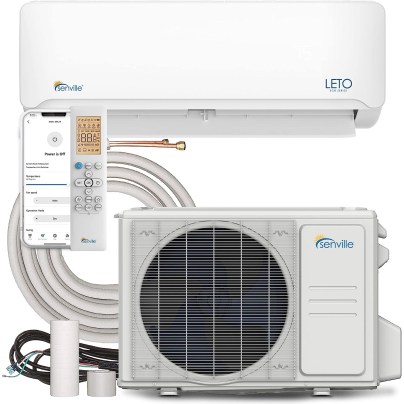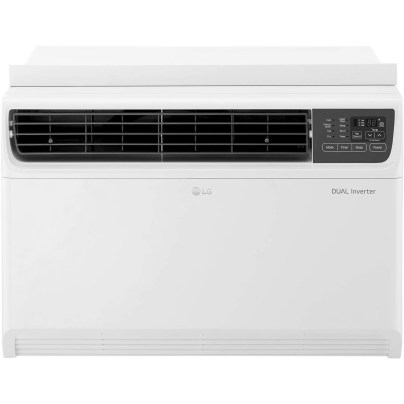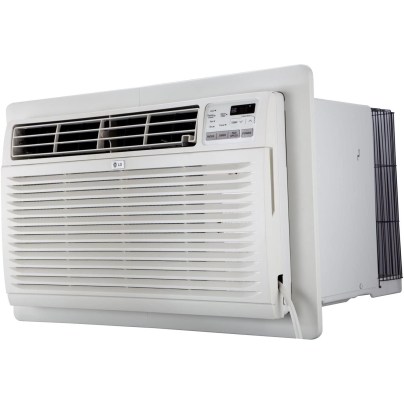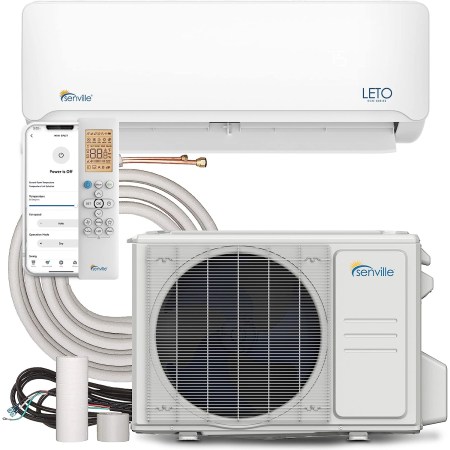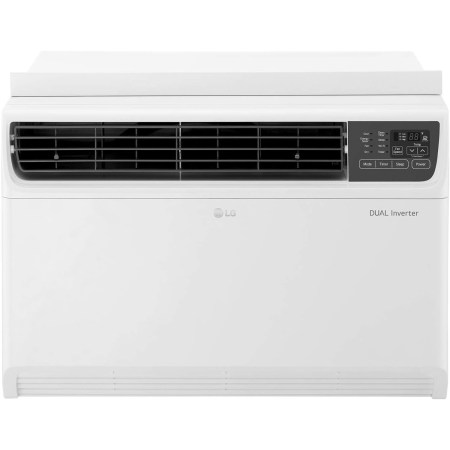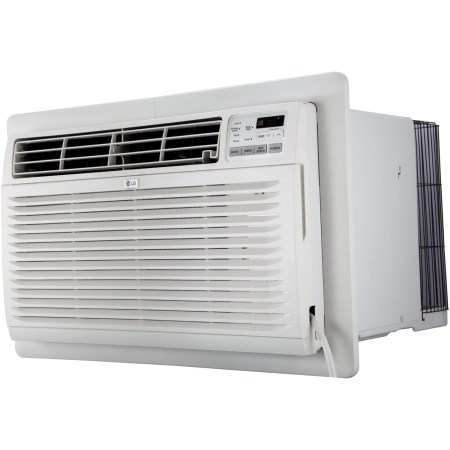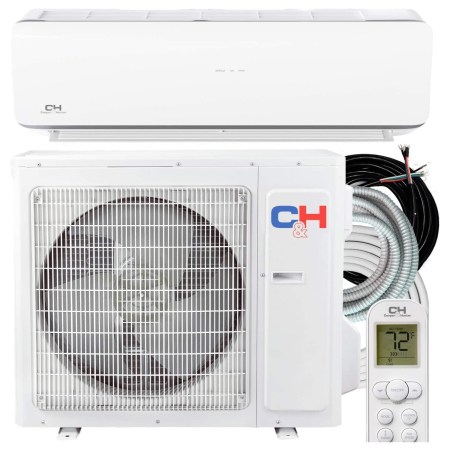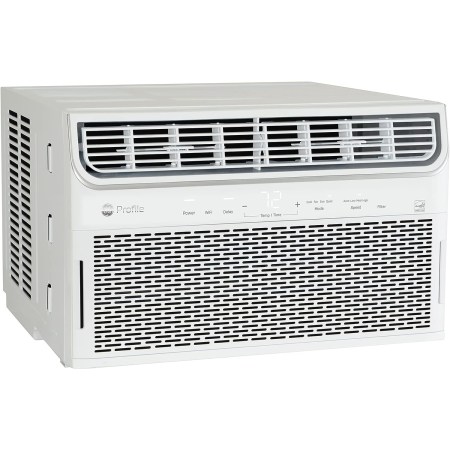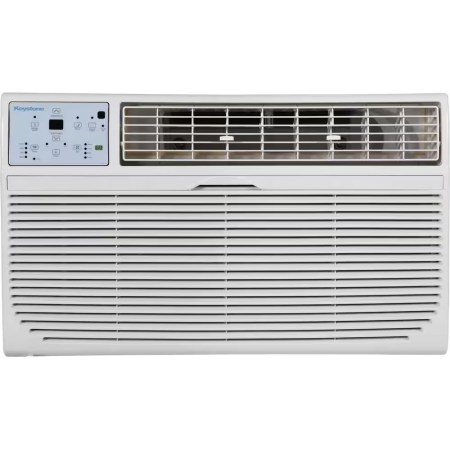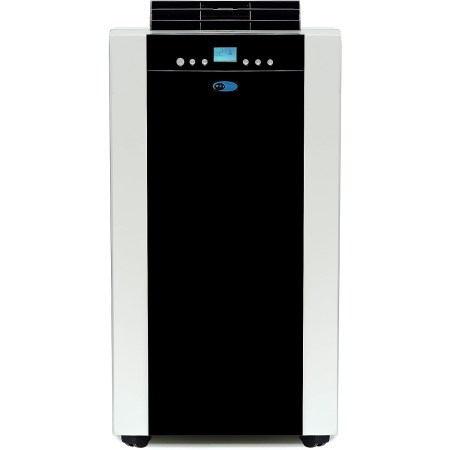We may earn revenue from the products available on this page and participate in affiliate programs. Learn More ›
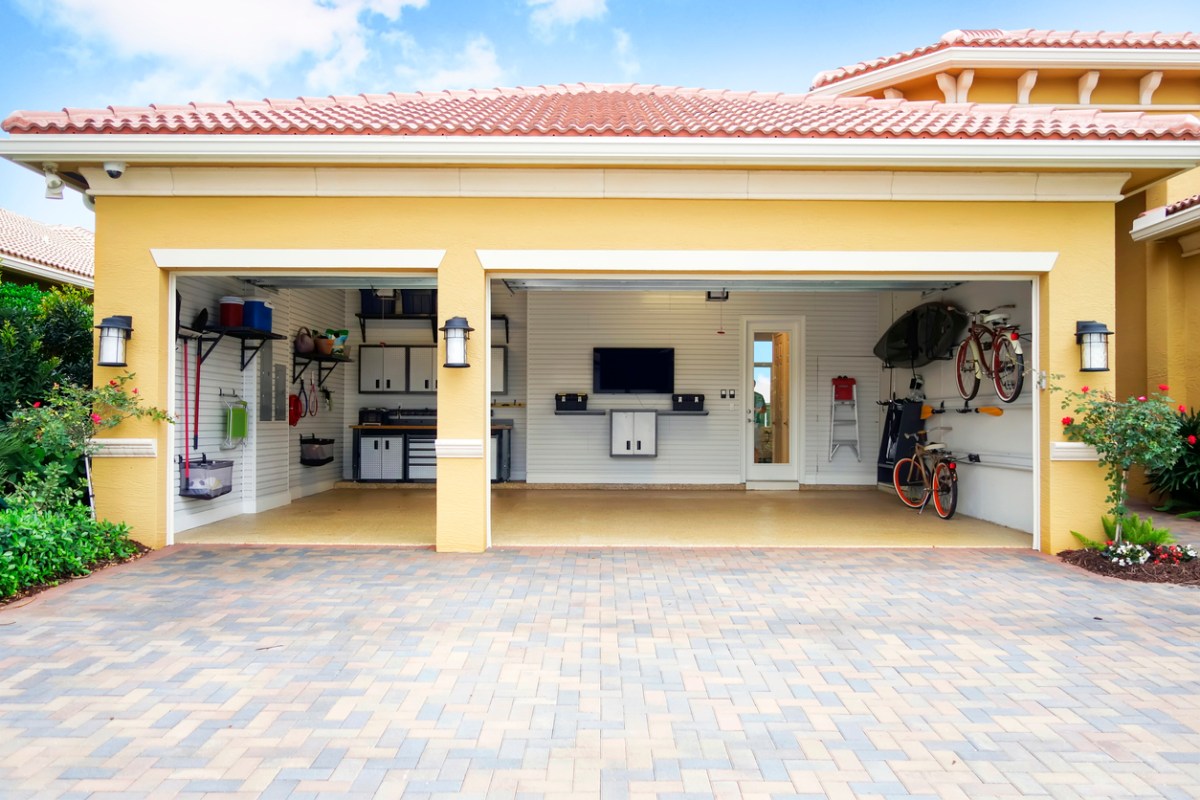
Capable air conditioners can transform sweltering garages into comfortable spaces. Whether you simply want a temperature-controlled storage environment or a cool space to tinker and work, air conditioners can make garage space more usable.
Air conditioner sizes and styles vary, and some are better than others for garages. The garage size is especially important when considering the air conditioner type and cooling abilities. Insulated garages are ideal for holding cool air, but any construction style can still benefit from a dedicated cooling system. The best garage air conditioners are efficient, reliable, and built to perform under rigorous heat.
- BEST OVERALL: Senville LETO 24,000 BTU Mini Split Air Conditioner
- BEST BANG FOR THE BUCK: LG 14,000 BTU Smart Window Air Conditioner
- BEST FOR SMALL GARAGES: LG 11,800 BTU Through-the-Wall Air Conditioner
- BEST FOR LARGE GARAGES: Cooper & Hunter Sophia 36,000 BTU Air Conditioner
- BEST FOR EFFICIENCY: GE Profile 10,100 BTU Smart Window Air Conditioner
- BEST FOR DIY INSTALLATION: Keystone 14,000 BTU Through-the-Wall Air Conditioner
- BEST FOR PORTABILITY: Whynter ARC-14S 14,000 BTU Portable Air Conditioner
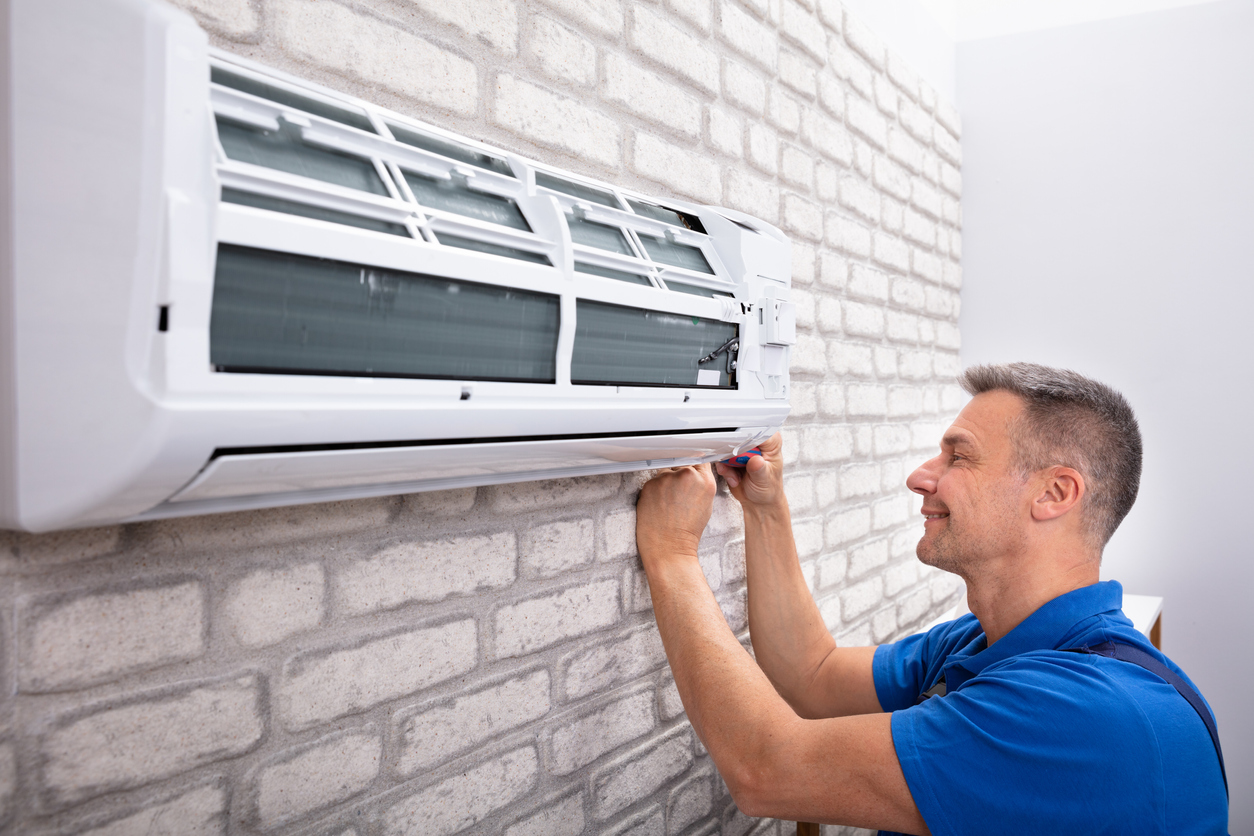
Before You Buy a Garage Air Conditioner
Understand that some garages have little or no insulation and poor ventilation, resulting in energy loss. The structures can trap and hold heat, creating a naturally uncomfortable space in hot weather. While a garage air conditioner can improve conditions, a garage’s lack of solid insulation and ventilation will make it work extra hard.
Address the issues that prevent heat from escaping naturally before installing an air conditioner. Look for holes in the lower levels where cold air will escape and cap them off. Additionally, add ventilation to the upper levels where hot air rises and can escape. Open and close these vents as needed to push out hot air and trap cold air inside. Add fans to circulate air, and your garage will be much easier to cool.
By taking action, your air-conditioning unit will work more efficiently and save on long-term energy expenses. The air conditioner can also last longer and deliver more consistent performance without stressing under constant heat.
How We Chose the Best Garage Air Conditioners
Plenty of brands, sizes, and styles of air conditioners are on the market, but not all are well suited to garage cooling. We considered the needs for different garage sizes ranging from a small 1-car to a larger 4-car space. A garage can function for storage or as a shop, home gym, living space, or any other common purpose.
When considering garage-specific air conditioners, we looked at British thermal unit (BTU) output for overall cooling abilities. We also considered different styles, including portable units, window units, through-the-wall installations, and mini-split options. Lastly, we looked at energy efficiency, user feedback, and overall design and functionality as they pertain to different garage sizes and uses.
Our Top Picks
Find the best garage air conditioners for your exact needs. From small hobby shops to large storage spaces, one of these models will make summer better indoors.
Best Overall
Senville LETO 24,000 BTU Mini Split Air Conditioner
See ItThose looking for a garage air conditioner that can quickly cool just about any space will appreciate this powerful mini-split. It sits neatly on a high wall while pumping cool (or hot) air into the garage. At 24,000 BTUs, it’s the most powerful option on the list. In addition, this same model comes in smaller and larger sizes, but 24,000 BTUs is typically ideal for cooling 2- to 4-car garages.
As a mini-split, this unit takes up minimal interior space; the bulk of the unit sits outside. It comes with an installation kit for DIYers, but using a professional service for installation is ideal. With hands-free operating options and powerful output, it’s an excellent choice for cooling a garage that doubles as a workspace or gym. This unit is made to work hard and handle the rigorous cooling needs of even a large garage. It has a seasonal energy efficiency ratio (SEER) of 18.
Product Specs
- BTUs: 24,000
- Energy efficiency: SEER 18
- Voltage: 220
Pros
- Compatible with Alexa for voice-command controls
- Also has a heat pump for warming the garage during cold periods
- Uses a DC inverter for substantial reduction in energy consumption
Cons
- Although installation kit is included, most users will need a professional to install the unit
- Voice controls for remote operation are only compatible with Alexa devices
- Mini-split is more expensive than window or portable units
Get the Senville garage air conditioner at Amazon or Walmart.
Best Bang For The Buck
LG 14,000 BTU Smart Window Air Conditioner
See ItWindow units are easy to set up for summer and remove when the hot season subsides. The LG 14,000-BTU model can cool 1- to 3-car garages or up to 800 square feet. For a little more or a little less cooling and cost, this model is also available in options of 8,000; 9,500; 12,000; 18,000; and 23,500 BTUs to fit different needs. This 14,000-BTU model has a combined energy efficiency ratio (CEER) of 14.7 and qualifies for Energy Star certification. (For a more detailed discussion of CEER, see the Energy Efficiency section after our product reviews.)
This LG window air conditioner has flexible settings with four different fan speeds that you can adjust through Alexa or Hey Google voice commands. A handy mobile app also acts as a convenient remote control. It fits standard window sizes with 27- to 39-inch widths and 16-inch heights. Users note the quiet nature of the air conditioner while in use. It also comes in at roughly half the price of what a buyer might pay for a mini-split.
Product Specs
- BTUs: 14,000
- Energy efficiency: CEER 14.7, Energy Star-certified
- Voltage: 115
Pros
- Easy to install and remove from standard-size windows for seasonal use
- Smart hands-free operations compatible with multiple voice platforms
- Dual inverter and energy-efficiency ratio will save on electric operating costs
- Multiple cooling modes and fan speeds allow for custom settings for optimal comfort
Cons
- Requires a compatible window, which some garages do not have
- Blocks some of the natural light and outside air circulation from coming through window
Get the LG 14,000-BTU garage air conditioner at Amazon, Lowe’s, or The Home Depot.
Best For Small Garages
LG 11,800 BTU Through-the-Wall Air Conditioner
See ItGarages made for one to two cars often fall under 600 square feet in size. The smaller space does not require a large air conditioner to reach and maintain reasonable temperatures. Window units are a great option for small spaces, as are portable units, but a through-the-wall air conditioner is really hard to beat for efficient cooling. Installation is a one-time process, and the air conditioner can remain on the wall year-round (you will have to cap the ventilation hole if removed.)
The convenience of having a dedicated air conditioner without installing a more involved mini-split is a win for many garage owners. This specific through-the-wall model is highly energy efficient, notably quiet, and has simple intuitive controls. The ability to use multiple fan speeds and cooling modes helps adjust the unit for more or less cooling power. A remote control is included as well.
It’s worth noting that this unit offers the ability to remove moisture from the air. In humid climates, it will pull moisture from the room and drain water out the back. Overall, this is a great option for those small to moderate spaces with reasonable insulation to hold cool air inside.
Product Specs
- BTUs: 11,800
- Energy efficiency: CEER 10.5; Energy Star certified
- Voltage: 115
Pros
- One-time installation in a permanent location saves DIY work or cost of installation pro
- Simple to install with basic tools (unless the walls are concrete)
- Excellent energy efficiency and cooling power in garages up to 530 square feet
- Multiple cooling levels and 3 fan speeds for customized settings
Cons
- Garage must have space and a suitable wall for drilling a hole and mounting unit
- Only designed for cooling, unless upgraded to a 230-volt model to add heat
- Designed for permanent mounting; removing the air conditioner will expose a hole
Get the LG 11,800-BTU garage air conditioner at Amazon, Lowe’s, or The Home Depot.
Best For Large Garages
Cooper u0026 Hunter Sophia 36,000 BTU Air Conditioner
See ItA big shop or garage space requires a powerful unit for consistent cooling. When the size exceeds 1,500 square feet, it’s time to step up the cooling capabilities. Cooper & Hunter manufactures some seriously powerful mini-split systems. They rival the abilities of a fully ducted air system without the HVAC investment of installing ducts.
The company backs this unit with a generous warranty offering 7 years of compressor protection alongside 5 years for parts. Installation is best done by a professional, but once installed, the unit requires little to no maintenance. As a mini-split designed for large spaces, this system is ideal for residential and commercial 3-car garages or larger.
While the outdoor compressor is heavy and large, the indoor wall-mounted piece sits fairly flat against the wall and has a low overall profile. You won’t need much wall space to hang the interior air handler, and it will pump out cold or hot air according to multiple cooling and fan settings.
Product Specs
- BTUs: 36,000
- Energy efficiency: SEER 16
- Voltage: 230
Pros
- High-powered mini-split unit capable of cooling 1,800 square feet
- Doubles as a heater with equal square-footage heating capabilities
- Wi-Fi capability allows for remote adjustments of settings
- Heavy-duty unit is designed to run constantly if needed
Cons
- The unit is shipped on pallets and is heavy; requires careful placement and professional installation
- Such a large and powerful unit comes with a higher level of energy consumption
Get the Cooper & Hunter garage air conditioner at Amazon or The Home Depot.
Best For Efficiency
GE Profile 10,100 BTU Smart Window Air Conditioner
See ItA 1-car garage and most 2-car garages can remain cool with this affordable, highly efficient window unit. An Energy Star-certified air conditioner, it has a 15.7 CEER rating for its power savings. It also runs at 40 decibels, which is quiet for a window unit. At less than $500 for the 10,100-BTU size, the cost of this garage air conditioner is competitive. Shoppers with moderate garages may find few downsides with the GE Profile. As with any window unit, its installation is not permanent, plus it requires a suitable window in the garage.
Efficiency is the big selling point for the GE Profile. It’s one of the most efficient window units available and will have a significant reduction on your power bill. Moreover, a mobile app makes it easy to schedule runtimes and control the unit remotely. If you forget to shut it down before leaving on a trip, just use the app. With remote-control abilities, your air conditioning will only run when needed.
Product Specs
- BTUs: 10,100
- Energy efficiency: CEER 15.7, Energy Star certified
- Voltage: 115
Pros
- Extremely efficient unit that operates with minimal power consumption
- Quiet while running at 40 decibels (considered low noise for air conditioner)
- 4 cooling levels and 3 fan speeds make it easy to customize settings
- Works with voice commands from Alexa and Google Assistant
Cons
- Not enough BTUs to be suitable for large garages; even the 13,500-BTU model is best for moderate spaces
- Temporary installation means it needs to be removed and stored after the season ends
- Will remove 1 window from use in the garage and will block some light
Get the GE Profile garage air conditioner at Amazon, Lowe’s, or The Home Depot.
Best For DIY Installation
Keystone 14,000 BTU Through-the-Wall Air Conditioner
See ItThis energy efficient-unit offers value and convenience and can easily cool most 2-car or 3-car garages. It’s not quite as efficient as the GE Profile model, but it still has a decent Energy Efficiency Ratio (EER) of 9.3 and the coveted Energy Star certification; the unit includes an energy-saver mode.
For DIYers who don’t have the tools and special HVAC training to install a mini-split, going through the wall is ideal. This unit is trimmed and ready for installation. You will want to find a good location and cut the hole for installation. Before finalizing the installation, a DIYer must add a wall sleeve (sold separately) to encase and protect the air conditioner. All of the installation is possible with basic tools.
After installing the Keystone air conditioner, you can change the settings to direct airflow in the desired directions. The unit’s Auto Cool setting offers a simple approach, or you can adjust the three cooling settings and fan speeds to reach your desired temperature.
Product Specs
- BTUs: 14,000
- Energy efficiency: EER 9.3
- Voltage: 230
Pros
- Filter is accessible from the front panel for easy cleaning or replacement
- Multiple fan speeds help you control cooling and air circulation
- Includes dehumidifiers to remove moisture during the cooling process
- Simple design, but unit offers reasonable operating efficiency and remote control
Cons
- Wall sleeve for installation must be purchased separately
- Air conditioner only; this unit does not have heating abilities
- Requires 230 volts and will not plug directly into a wall outlet
Get the Keystone garage air conditioner at Amazon, Lowe’s, or The Home Depot.
Best for Portability
Whynter ARC-14S 14,000 BTU Portable Air Conditioner
See ItPortability offers a number of advantages for a garage AC unit. The unit can cool a number of different locations, depending on activities. This means you might set up cooling near a workbench one day and move it to the other side of your garage (or into the house) to work on organizing storage the next. All that’s needed is any size window or opening to insert the adjustable vent plate.
This model has been around since the year 2000 and is proven in terms of reliability and performance. While it’s not the most efficient, the design is intuitive, and it has excellent cooling power for a portable air conditioner. Garages that fit one or two cars will benefit most from the 14,000-BTU cooling capabilities.
The Whynter ARC-14S is available with air conditioning only or with a heat/AC combo option. Buyers can choose according to their indoor climate and needs throughout the year. It’s reasonably quiet (56 decibel) when cooling, and you can easily set a thermostat to control your comfort.
What our team says: Stephanie Cronk, Bob Vila executive editor and product tester, says about this air conditioner, “This was among the most powerful portable AC units we tested. We turned the unit on when our 600 square-foot room reached 80 degrees Fahrenheit…and the room was noticeably cooler within 10 minutes.”
Product Specs
- BTUs: 14,000
- Energy efficiency: SEER 7.69
- Voltage: 115
Pros
- Thermostat is ideal for set-it-and-forget-it control of comfort level
- Portability makes it simple to set up quickly and remove entirely without modifying a garage
- Offers powerful cooling abilities, plus fan and dehumidifying modes in a portable unit
- Has a digital panel, remote control, and 24-hour timer for comfort control
Cons
- Could be more efficient to reduce energy usage and save on costs
- Still requires a (small) window or opening for exterior ventilation through hose
- Reasonably quiet but noisier than some air conditioner models
Get the Whynter garage air conditioner at Amazon, The Home Depot, or Best Buy.
Jump to Our Top Picks
What to Consider When Choosing a Garage Air Conditioner
Before buying a garage air conditioner, do a thorough review of the installation requirements, power needs, energy efficiency, and overall BTU output. Some models, like the more involved mini-splits, require a hardwired electrical connection while others need only a standard outlet. Some common models plug in, but only to 220-volt outlets. Regardless, the energy draw is significant on most air conditioners, and you’ll want to review available energy ratings to ensure the unit does not overload an electrical circuit. Otherwise, look for the right size and focus on energy efficiency to minimize operating costs.
Size
Physical size is an important consideration for garages. A large air conditioner requires space. Window units remove light from entering and portable units take up floor space. Through-the-wall units can mount in a permanent location that is convenient to wall space uses or needs. Mini-split units are ideal because they mount high on the wall and take up very little interior space.
Think through the space available and where the cooling is needed most within the garage. The coldest areas will be those nearest to the air conditioner. Fans can help distribute that air across the entire floor, however.
Energy Efficiency
Efficiency is relative to output. A higher number of BTUs increases energy consumption but also will cool a relatively large space. For example, a 10,000-BTU unit is sufficient for garages under 400 square feet (or one to two cars). A garage with 800 to 1,200 square feet will require a unit with higher BTUs (20,000+), and thus use more home energy.
The EER is a measure of the cooling capacity per watt of energy used. An EER of 9 is above average, and an EER of 12 is considered excellent. The higher the rating, the more efficient, which means lower electricity use and emissions. SEER is a seasonal ratio that calculates average energy over a cooling season, and most rate as 13 to 21.
The CEER is a newer, similar rating system that also takes into account standby power consumption. A CEER rating of 10 or above is considered good. In addition, if the unit is Energy Star certified by the Environmental Protection Agency, you can expect a high level of efficiency.
Efficiency is important as an environmental consideration, and it influences a home’s power bill. The cost savings in terms of energy consumption often justify spending more on an efficient unit when weighed against the long-term cost savings on power and environmental impact.
Additional Features
While size and efficiency are important, garage users will want added features to help control and enjoy the air-conditioning unit. A quality remote control makes it easy to adjust temperature settings quickly. Remote controls are especially nice for units mounted high on the wall.
Eco settings and noise reduction also factor into desired features. A garage doesn’t always need the full power an air conditioner offers, and it’s nice to cycle on lower settings while conserving energy at times. Quiet units minimize disturbance in garages, which typically have concrete floors and little natural sound reduction. A decibel rating might be an important factor to check.
Lastly, units that double as heaters are an excellent investment for year-round use. For property owners living in environments where temperatures are cold and hot, the double use maximizes the value of the investment.
Types of Garage Air Conditioners
The type of air conditioner you choose makes a big difference in terms of capabilities and purpose. For those who want to cool a small area within the garage, like a work space, portable units are great options. For complete cooling, a window unit can handle some garages, but a mini-split is more capable for large spaces. Assess the garage thoroughly, taking cooling needs, budget, and installation into consideration, and make an educated decision.
Mini-Split
Often referred to as ductless heating and cooling systems, the mini-split is a great system for garages. It functions as a heating and cooling system that uses a heat pump to remove hot air and replace it with air that runs across a compressor and cooling tubes before entering the garage. Installation is somewhat more involved and often calls for a professional to set up the unit. Once installed, mini-splits are simple and cost-effective when compared to duct systems. For larger garages, the mini-split is often a top choice.
Through-the-Wall
Some garages lack standard windows. In this case, a through-the-wall air conditioner functions in the same manner but vents through a drilled hole in the garage wall. The unit pulls hot air from the garage, removes humidity, cools the air, and recirculates cold air into the room. Installation is surprisingly easy unless a garage has a thick concrete or cinder-block wall where drilling isn’t feasible. The permanent mounting style leaves windows free and doesn’t require removal after the hot season.
Window
Garage window units are an excellent option, especially for seasonal use. Installing requires a compatible garage window and removal of screens or making slight modifications to get the right fit. Window units are designed to sit on the window base while fitting flush to seal off the outside elements. They come in a large variety of BTU options to suit different garage sizes. Window units have long been a reliable cooling option that are removable when not in use. They are cost-effective and widely available.
Portable
Portability makes it possible to use an air conditioner only when needed (and wherever needed). You can pack it away quickly or easily move it to different areas in the garage. Some portable units still require a window or opening for air ducts to reach the exterior. A few rare units run entirely independent of outside ventilation as well.
The Advantages of Using a Garage Air Conditioner
Garages can become so hot during summer and so cold in winter that the space is uninhabitable. While it can still serve as a storage space, the temperature swings are extreme enough that the garage can become lost square footage to a degree. By adding a cooling system, you can spend more time using any size of garage space.
- Cool large spaces with a single AC unit.
- Make the garage or workshop space temperate and comfortable.
- Energy-efficient options are available for garage users.
- Some air-conditioning units double as heaters for use in cold temperatures.
FAQs
Shoppers can often become overwhelmed by the number of options in the air-conditioner market. We have answered the most common questions to help narrow the field and highlight air conditioner types and styles suited for use in garages. Always compare important factors like installation requirements, energy efficiency, and brand reputation when shopping for the best garage air-conditioning unit.
Q. How can I cool my garage quickly?
Reaching a cool temperature can be achieved by venting out hot air. Open windows and vents at night and cover or close them off in the morning to trap cooler air. Turn on an air conditioner to cool the space more quickly as it warms.
Q. What is the best way to air condition a 2-car garage?
It depends on the specific situation. A mini-split is the best overall option but you can effectively cool the space with a window unit, portable air conditioner, or through-the-wall unit.
Q. How big of an AC do I need for a garage?
The size of a garage will influence BTU needs. Air conditioners in the range of 10,000 to 24,000 BTUs are common for garage square footage.
Q. What kind of AC can I put in my garage?
You can install any type of AC in your garage. A mini-split is a permanent solution, while other types such as portable or window air conditioners are temporary or seasonal solutions.
Why Trust Bob Vila
Bob Vila has been America’s Handyman since 1979. As the host of beloved and groundbreaking TV series including “This Old House” and “Bob Vila’s Home Again,” he popularized and became synonymous with “do-it-yourself” home improvement.
Over the course of his decades-long career, Bob Vila has helped millions of people build, renovate, repair, and live better each day—a tradition that continues today with expert yet accessible home advice. The Bob Vila team distills need-to-know information into project tutorials, maintenance guides, tool 101s, and more. These home and garden experts then thoroughly research, vet, and recommend products that support homeowners, renters, DIYers, and professionals in their to-do lists.
